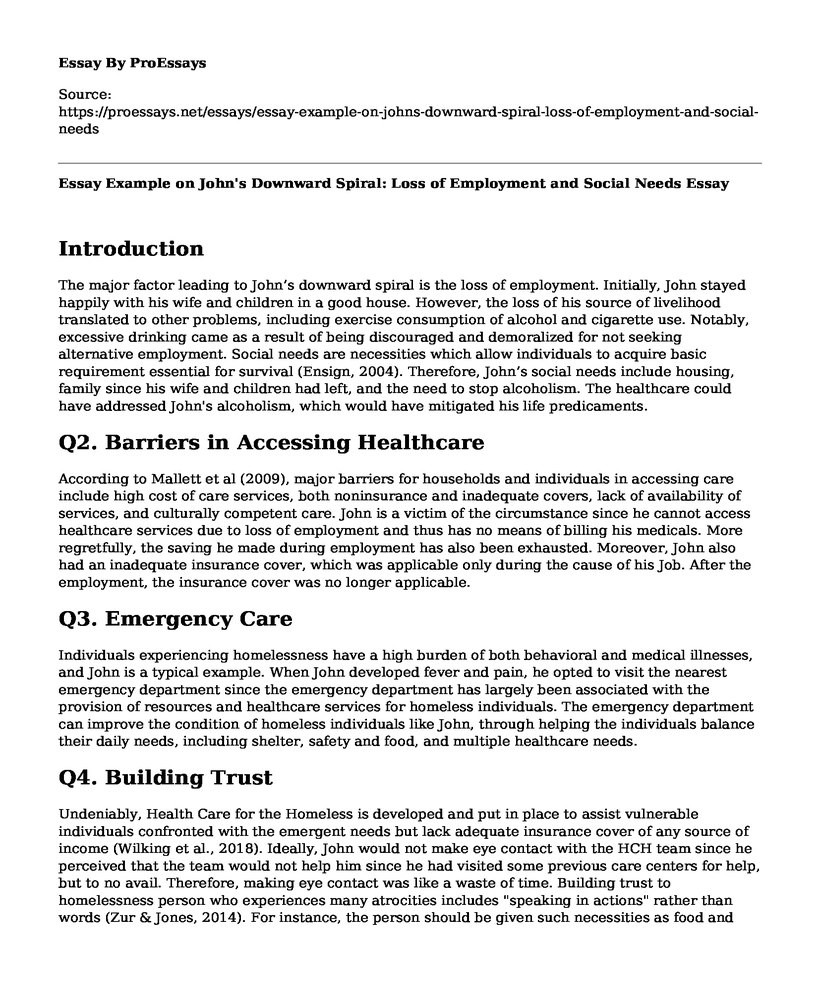Introduction
The major factor leading to John’s downward spiral is the loss of employment. Initially, John stayed happily with his wife and children in a good house. However, the loss of his source of livelihood translated to other problems, including exercise consumption of alcohol and cigarette use. Notably, excessive drinking came as a result of being discouraged and demoralized for not seeking alternative employment. Social needs are necessities which allow individuals to acquire basic requirement essential for survival (Ensign, 2004). Therefore, John’s social needs include housing, family since his wife and children had left, and the need to stop alcoholism. The healthcare could have addressed John's alcoholism, which would have mitigated his life predicaments.
Q2. Barriers in Accessing Healthcare
According to Mallett et al (2009), major barriers for households and individuals in accessing care include high cost of care services, both noninsurance and inadequate covers, lack of availability of services, and culturally competent care. John is a victim of the circumstance since he cannot access healthcare services due to loss of employment and thus has no means of billing his medicals. More regretfully, the saving he made during employment has also been exhausted. Moreover, John also had an inadequate insurance cover, which was applicable only during the cause of his Job. After the employment, the insurance cover was no longer applicable.
Q3. Emergency Care
Individuals experiencing homelessness have a high burden of both behavioral and medical illnesses, and John is a typical example. When John developed fever and pain, he opted to visit the nearest emergency department since the emergency department has largely been associated with the provision of resources and healthcare services for homeless individuals. The emergency department can improve the condition of homeless individuals like John, through helping the individuals balance their daily needs, including shelter, safety and food, and multiple healthcare needs.
Q4. Building Trust
Undeniably, Health Care for the Homeless is developed and put in place to assist vulnerable individuals confronted with the emergent needs but lack adequate insurance cover of any source of income (Wilking et al., 2018). Ideally, John would not make eye contact with the HCH team since he perceived that the team would not help him since he had visited some previous care centers for help, but to no avail. Therefore, making eye contact was like a waste of time. Building trust to homelessness person who experiences many atrocities includes "speaking in actions" rather than words (Zur & Jones, 2014). For instance, the person should be given such necessities as food and shelter; then, eventually, he will give an audience to the concerned. Despite John making eye contact after being given food, he had no otherwise after several days to give the HCH attention since he perceived the group as different from other places he had visited.
Q5. Aspect of HCH
Ideally, patient engagement and signing up John for health insurance is the most quality care aspect from the HCH. John could now be entitled to quality health care services through Medicaid and also enjoy various food benefits. The move brought hope to John as he now feels comfortable and appreciates the work of the clinic. Ideally, Maggie made John feel like a real person by offering him a listening ear.
Q6. Personal Experience
As a matter of fact, I have encountered a homeless individual on the streets. The individual was spending his night along the streets with no blanket or proper clothing to put on. I thought I could help as I placed myself in his position.
References
Ensign, J. (2004). Quality of health care: The views of homeless youth. Health Services Research, 39(4p1), 695-708. https://doi.org/10.1111/j.1475-6773.2004.00253.x
Mallett, S., Rosenthal, D., Keys, D., & Averill, R. (2009). Moving out, moving on young people's pathways in and through homelessness. Routledge.
Wilking, J., Roll, S., Philhour, D., Hansen, P., & Nevarez, H. (2018). Understanding the implications of a punitive approach to homelessness: A local case study. Poverty & Public Policy, 10(2), 159-176. https://doi.org/10.1002/pop4.210
Zur, J., & Jones, E. (2014). The unmet need among homeless and non-homeless patients served at health care for the homeless programs. Journal of Health Care for the Poor and Underserved, 25(4), 2053-2068. https://doi.org/10.1353/hpu.2014.0189
Cite this page
Essay Example on John's Downward Spiral: Loss of Employment and Social Needs. (2023, Aug 28). Retrieved from https://proessays.net/essays/essay-example-on-johns-downward-spiral-loss-of-employment-and-social-needs
If you are the original author of this essay and no longer wish to have it published on the ProEssays website, please click below to request its removal:
- Understanding Typologies and Characteristics of Terrorism Essay
- "Where Do the Mermaids Stand?" - Voice and Body in The Little Mermaid movie By Laura Sells
- Paper Example on Racism as a Universal Disease
- What is the Social Order in Grenada? - Essay Sample
- Essay Example on Global Refugee Crisis: 44,000 Displaced Persons Daily in 2017
- Paper Example on OMB Directive 15: Promoting Integration Through Research on Racial Segregation
- Essay Example: Winning the War on Urban Terrorism in the US







